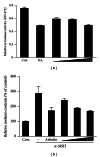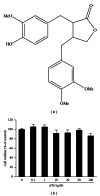Inhibitory Effect of Arctigenin from Fructus Arctii Extract on Melanin Synthesis via Repression of Tyrosinase Expression
- PMID: 23781272
- PMCID: PMC3678497
- DOI: 10.1155/2013/965312
Inhibitory Effect of Arctigenin from Fructus Arctii Extract on Melanin Synthesis via Repression of Tyrosinase Expression
Abstract
To identify the active compound arctigenin in Fructus Arctii (dried seed of medicinal plant Arctium lappa) and to elucidate the inhibitory mechanism in melanogenesis, we analyzed melanin content and tyrosinase activity on B16BL6 murine melanoma and melan-A cell cultures. Water extracts of Fructus Arctii were shown to inhibit tyrosinase activity in vitro and melanin content in α -melanocyte stimulating hormone-stimulated cells to similar levels as the well-known kojic acid and arbutin, respectively. The active compound arctigenin of Fructus Arctii displayed little or no cytotoxicity at all concentrations examined and decreased the relative melanin content and tyrosinase activity in a dose-dependent manner. Melanogenic inhibitory activity was also identified in vivo with zebrafish embryo. To determine the mechanism of inhibition, the effects of arctigenin on tyrosinase gene expression and tyrosinase promoter activity were examined. Also in addition, in the signaling cascade, arctigenin dose dependently decreased the cAMP level and promoted the phosphorylation of extracellular signal-regulated kinase. This result suggests that arctigenin downregulates cAMP and the tyrosinase enzyme through its gene promoter and subsequently upregulates extracellular signal-regulated kinase activity by increasing phosphorylation in the melanogenesis signaling pathway, which leads to a lower melanin content.
Figures





References
-
- Cordell GA, Colvard MD. Natural products and traditional medicine: turning on a paradigm. Journal of Natural Products. 2012;75(3):514–525. - PubMed
-
- Solano F, Briganti S, Picardo M, Ghanem G. Hypopigmenting agents: an updated review on biological, chemical and clinical aspects. Pigment Cell Research. 2006;19(6):550–571. - PubMed
-
- Nguyen DTM, Nguyen DH, Lyun HL, Lee HB, Shin JH, Kim EK. Inhibition of melanogenesis by dioctyl phthalate isolated from Nigella glandulifera Freyn. Journal of Microbiology and Biotechnology. 2007;17(10):1585–1590. - PubMed
-
- Lv N, Koo JH, Yoon HY, et al. Effect of Angelica gigas extract on melanogenesis in B16 melanoma cells. International Journal of Molecular Medicine. 2007;20(5):763–767. - PubMed
LinkOut - more resources
Full Text Sources
Other Literature Sources

